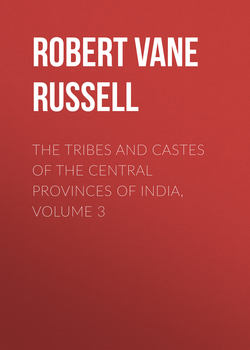Читать книгу The Tribes and Castes of the Central Provinces of India, Volume 3 - Robert Vane Russell - Страница 55
Gond
(e) Funeral Rites
37. Bringing back the soul
ОглавлениеThey believe that the spirits of ancestors are reincarnated in children or in animals. Sometimes they make a mark with soot or vermilion on the body of a dead man, and if some similar mark is subsequently found on any newborn child it is held that the dead man’s spirit has been reborn in it. In Bastar, on some selected day a short time after the death, they obtain two small baskets and set them out at night, placing a chicken under one and some flour of wheat or kutki under the other. The householder then says, “I do the work of those old men who died. O spirits, I offer a chicken to you to-day; be true and I will perform your funeral rites to-morrow.” On the next morning the basket placed over the flour is lifted up, and if a mark resembling a footprint of a man or any animal be found, they think that the deceased has become incarnate in a human being or in that animal. Subsequently they sacrifice a cow to the spirit as described. In other places on the fifth day after death they perform the ceremony of bringing back the soul. The relatives go to the riverside and call aloud the name of the dead person, and then enter the river, catch a fish or insect and, taking it home, place it among the sainted dead of the family, believing that the spirit of the dead person has in this manner been brought back to the house. The brother-in-law or son-in-law of the dead man will make a miniature grass hut in the compound and place the fish or insect inside it. He will then sacrifice a pig, killing it with a rice-husker, and with not more than three blows. The animal is eaten, and next morning he breaks down the hut and throws away the earthen pots from the house. They will spread some flour on the ground and in the morning bring a chicken up to it. If the animal eats the flour they say that the soul of the deceased has shown his wish to remain in the house, and he is enshrined there in the shape of a stone or copper coin. If it does not eat, then they say that the spirit will not remain in the house. They take the stone or coin outside the village, sacrifice a chicken to it and bury it under a heap of stones to prevent it from returning. Sometimes at the funeral ceremony one of the party is possessed by the spirit of the dead man, and a little white mark or a small caterpillar appears on his hand, and they say that it is the soul of the dead man come back. Then the caterpillar vanishes again, and they say that the dead man has been taken among the gods, and go home. Occasionally some mark may appear on the hand of the dead man’s son after a period of time, and he says that his father’s soul has come back, and gives another funeral feast. The good souls are quickly appeased and their veneration is confined to their descendants. But the bad ones excite a wider interest because their evil influences may be extended to others. And the same fear attaches to the spirits of persons who have died a violent or unnatural death. The soul of a man who has been eaten by a tiger must be specially propitiated, and ten or twelve days are occupied in bringing it back. To ascertain when this has been done a thread is tied to a beam and a copper ring is suspended from it, being secured by twisting the thread round it and not by a knot. A pot full of water is placed below the ring. Songs are then sung in propitiation and a watch is kept day and night. When the ring falls from the thread and drops into the water it is considered that the soul has come back. If the ring delays to fall they adjure the dead man to come back and ask where he has gone to and why he is tarrying. Animals are offered to the ring and their blood poured over it, and when it finally falls they rejoice greatly and say that the dead man has come back. The ancestors are represented by small pebbles kept in a basket in the kitchen, which is considered the holiest part of the house, or they may be pice copper coins (¼d.) tied up in a little bundle. They are daubed with vermilion and worshipped occasionally. A man who has been killed by a tiger or cobra may receive general veneration, with the object of appeasing his spirit, and become a village god. And the same honour may be accorded to any prominent man, such as the founder of a village.
